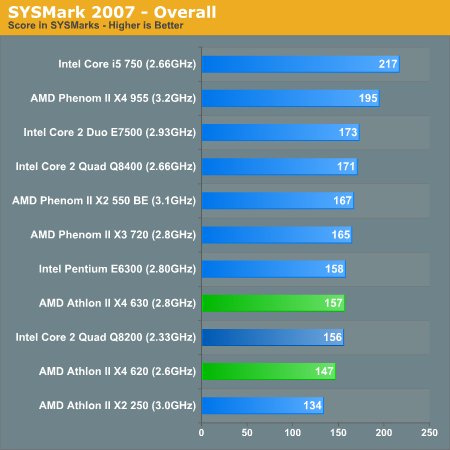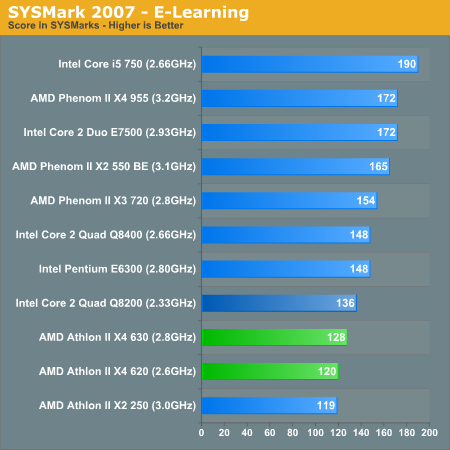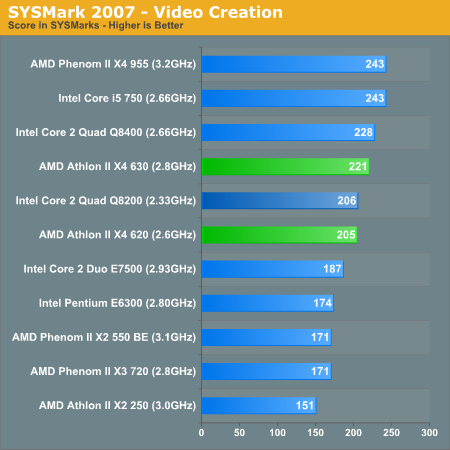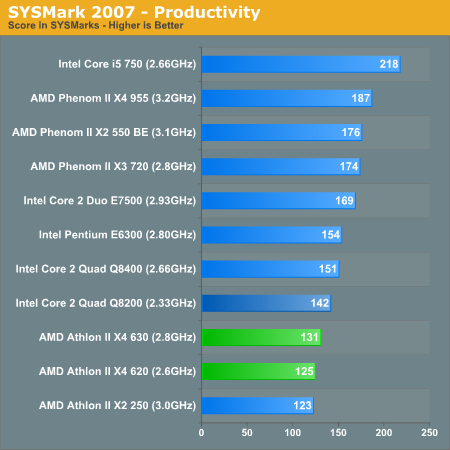AMD Athlon II X4 620 & 630: The First $99 Quad Core CPU
by Anand Lal Shimpi on September 16, 2009 12:00 AM EST- Posted in
- CPUs
SYSMark 2007 Performance
Our journey starts with SYSMark 2007, the only all-encompassing performance suite in our review today. The idea here is simple: one benchmark to indicate the overall performance of your machine.

If we only look at the AMD numbers in this chart, there's a pretty nice lineup going on here. The Athlon II X2 250 is slower than the Athlon II X4 620/630, which is slower than the Phenom II X3 730 and all are slower than the Phenom II X4 955. The performance lines up with the pricing, so all is good.
The problem with these cheap quad-cores has always been that you give up a lot in order to get four cores at a low price. The Athlon II X4 appears to break the mold however. The Athlon II X4 620 is priced at $99 and it performs like a $99 CPU. With the exception of the Core 2 Duo E7500 whose high clock speed makes it do unsually well here, the 620 is balanced. You get a reasonably high clock speed and enough cache to be competitive, both at a good price.
You'll see in the individual tests below that performance varies between competitive and underwhelming depending on the task. Anything that can take advantage of four cores does well, otherwise the smaller L2s of the Athlon II X4 hurt it a bit.

In applications that aren't well threaded, you'll see the Athlon II X4 perform less than stellar - but the same is true for all lower end quad-core CPUs. Even the Q8200 is outperformed by the E6300 here. Situations like this are validation for Intel's aggressive turbo modes on Lynnfield.

Any strenuous video encoding however will seriously favor the Athlon II X4. Here we find the $99 620 tying the Core 2 Quad Q8200, and the 630 outperforming it - all at a lower price.

We're back to needing higher clock speeds and larger caches to compete. Being a quad-core processor isn't easy.











150 Comments
View All Comments
silverblue - Wednesday, September 16, 2009 - link
Sure, AMD has been forced to realise that competing at the higher end is a worthless exercise thanks to Lynnfield, however they've had Propus on their roadmap for a year now so I'd hardly term it "Emergency Edition". It's not a clock-speed bump like a certain Emergency Edition we all remember (how much did the various P4 EEs cost again?).With AMD providing a more complete platform, and especially one that allows for easy upgrades, the new Athlon II X4s could work for them in that it'll be cheap to upgrade from the old Athlon X2s as well as relatively inexpensive to build a new setup with CPU/motherboard/RAM (remember the onboard Radeon still runs rings around any Intel IGP). I doubt that i5/i7 sales make up most of their current order book (hell, they're still advertising Core2 on television and in IT publications here in the UK) so, like with graphics cards, the majority of the money stands to be made from mainstream and value products. As someone said before, this could be great for OEMs to improve their margins, as well as AMD if it means more bundles are sold. What's more, as things get more multi-threaded, dual cores fall more and more below the curve.
I'm interested in seeing what Intel does, and even though their market share has grown again this quarter, I don't believe they can just do nothing about the Athlon II X4. Generally, below $150 or so, AMD does offer better performance for the price, even if, per clock, an Intel chip does more (and it's not always down to Intel-specific optimisations either) and earns its maker more money.
silverblue - Wednesday, September 16, 2009 - link
Slight clarification on the P4 EE; it wasn't just a clock speed bump (3.2GHz -> 3.46GHz -> 3.73GHz) as, for example, the FSB was increased with the 3.46GHz model to 1066MT/s, then the core changed from Gallatin to Prescott (inc. extra cache) for the 3.73GHz model.Don't want anyone to think I just picked on the P4 EE just because it was fashionable or anything :)
Ratman6161 - Wednesday, September 16, 2009 - link
Microcenter is advertising a special on the i5 750 at $159. But even at the full $206 suggested retail, if you are really doing something that benefits from 4 cores, it doesn't really make sense to me to go with anything less. There are even 1166 motherboards for just over $100 so the $99 quad just isn't saving enough to make it worthwhile.gstrickler - Wednesday, September 16, 2009 - link
On page 6 of the review the Excel Monte Carlo Simulation test shows the Q8200 (2.33GHz) being faster than the Q8400 (2.66Ghz)Same thing happens again on page 7 on the WinRAR Archive Creation test.
You didn't mention it in the text and it's very unlike you to overlook or fail to comment on such an odd result.
flipmode - Wednesday, September 16, 2009 - link
you saidOverclocking suffers a bit as the chips capable of the highest clocks are destined to be Phenom IIs.
And I think this does not make any sense. These are probably manufactured on their own wafers, and they are not Deneb dice, but completely different dice, so regardless of the clockspeed that any individual die is capable of, it cannot become a Phenom 2.
Anand Lal Shimpi - Wednesday, September 16, 2009 - link
You're quite right :) I clarified in the article. That would apply to rebadged Denebs, but as to why the Propus core doesn't clock so well it's not totally clear to me at this point.It could be a design decision or just the impact of manufacturing a brand new die or just a bad sample.
Note that I could get the chip a lot higher but it wasn't stable by my definition :)
Take care,
Anand
gstrickler - Wednesday, September 16, 2009 - link
It's not overclocking. These chips are rated to run at "turbo" speed indefinitely. Each of the 4 cores is capable of running at that speed. However, for power and thermal management of all 4 cores, the on chip power management "underclocks" the cores dynamically depending upon load to keep the combination of all active cores from exceeding thermal and power limits.Intel is being very honest in listing the speed as the slowest speed at which all 4 cores can run concurrently, even though they're all rated to run 1.5x bus multiplier steps faster. The difference between the slowest "underclock" and "turbo" mode on the upcoming Core i7 mobile chips is reported to be much more than 1.5x (~6x). Again, that's for power (mostly) and thermal management, allowing it to operate as a fast single/dual-core or slower tri/quad core depending upon current usage.
The reality is that most software can't currently take advantage of more than 1 or 2 cores, and for those applications, you're going to get the benefits of turbo mode. When you're running tasks that can benefit from 3 or 4 cores, the cores reduce their clock to limit the power and heat, giving lower performance on each thread, but higher total throughput.
The user gets the benefits of a fast dual core and a slower quad core, depending upon current load. Because all of that power management is handled by the PM on the CPU, it's transparent to the OS.
The0ne - Wednesday, September 16, 2009 - link
I see many angry users concern about the term overclocking. It strikes me hilarious that people really claim to know what Intel is and/or have actually done with their chip.I too agree it is not a fair comparison because the Turbo mode does increases the frequency. Granted that this is a feature of the chip itself but that is a feature that is not present on the AMD and hence isn't a apples to apples comparison. If you're going to represent Intel with a 600MHGhz boost why not compare it to a regular clocked AMD and an AMD chip that is clocked around the same turbo-boosted speed. That would be a fair comparison and would give anyone a clearer picture.
The reason why the arguments by most of the users here are hilarious to me is that I don't think they have a clue to how the CPU's were tested. We have had CPU's that were generally locked to keep the speed/price ration. This "feature" was not presented as a feature to the consumer but once the market found out the chip could actually provide more then they in a sense enabled it. So the difference here now is is that Intel is making this available, unlocked and calling it a feature and suddenly cries of joy and stupidity are abound. Yes, yes, the technology isn't entirely the same but the end result is.
Do you seriously think Intel did not overstress test their chips and fool-heartily tested only at stock. Do you think they didn't test them in turbo mode and still continue until the chip died? I can't recount the 30 years on my engineering career not having to test products in the extreme range of just about anything (temp, vibration, shock, emc, drop, shipping, customer use, etc.). If you are an engineer and don't do this you shouldn't be selling your shtty product, end of conversation. Feel free to disagree and be laugh at by the industry.
Having said of of this the simple matter is that if Intel's feature is boosting the clock by 600, then why not compare an AMD chip with similarly clocked speed? And further more, why do you even rant about having to do this in the first place? Getting caught up in this "overclocking" terminology and not looking beyond what stands to reason is ignorant. At the very least I would hope to see the lower price Intel I5/I7 compare with the competition in default and turbo modes. Why wouldn't YOU?
Flame away,
Ratman6161 - Wednesday, September 16, 2009 - link
Weather its overclocking or not, leaving the turbo feature on the i5 makes it a good comparison for those people who want to just plug in the chip and run it within its specs. You are comparing "out of the box" speed of one versus the other. It doesn't make sense for every one, but I think the article gave enough information for the knowledgeable reader to make their own decisions.pervisanathema - Wednesday, September 16, 2009 - link
How can anyone advocate intentionally crippling the superior product in order to make the comparison more favorable for the competition? That's like a car magazine intetionally removing the turbo from a factory turbo charged vehicle so "that would be a fair comparison and would give anyone a clearer picture."